But
because our mother or father may not have rocked us when we were babies, we go
to the closed door and keep knocking on it hoping they will come out now when we
are 54 and rock us and love us and then WE THINK . . . we will feel good,
we will be loved.
Here
is a quote from Fr. Carter's book Response to God's Love. There may be
lots of people giving us love today and we are missing it and not appreciating
it because we want it from a certain person.
The
people in our lives are with us today. We must thank God for the love we have
and accept God's will for our life today.
On one Hail Mary bead or as many as you desire, say: (this is given for Fr.
Carter, you can replace your loved one's name).
Pray the Hail Mary or Hail Mary's then pray this after the Hail Mary.
After the Glory Be— pray the following petition.
Note: You can look at Mary on the image rosary while you pray this rosary.
7
Liturgical Participation
The Church's existence centers in her liturgy: "The liturgy is the summit
toward which the activity of the Church is directed; at the same time it is the
fount from which all her power flows" (Vatican II, Constitution on the Sacred Liturgy,
no. 10). Furthermore, the Church's liturgical life is centered in the sacraments
and, most especially, in the eucharistic sacrifice. We will briefly consider the
sacraments in general, and then more extensively develop ideas about the Mass.
In the
previous chapter, we stated that the Church, in union with Christ, her head,
helps continue the work of Jesus according to the pattern of Jesus. One aspect
of Christ's existence, we stated, was that he was the primordial sacrament of
God. We concluded, therefore, that the Church is also sacrament. The Church's
sacramentality is then actualized in a special manner through the seven
sacraments. In the same way that the Church in general is the visible
continuation of Christ's Incarnation, so also can her individual sacraments be
considered particular, visible extensions of Jesus.
It is
evident, therefore, why the sacraments are special encounters with Christ. Jesus
unites himself with the sacramental sign as he offers his grace to the
recipient. In this sense, Christ and his sacraments become one; the sacrament
and its minister are merely instruments that Christ employs to give himself
anew. The primary sacramental encounter is between Jesus and the recipient.
Christ
offers himself through the Church and her sacraments so that we might become
ever more united to him. This incorporation into Christ begins at baptism,
through which the Christian becomes a member of both Christ and the Church. What
is more, this incorporation into the life of Christ means being incorporated
into his paschal mystery because death-resurrection was the summary mystery of
Christ's existence. Death-resurrection was the central mystery whereby Christ
gave us life, and it is the central mystery that the Christian must relive in
Christ.
Each one of the sacraments deepens our incorporation
into Jesus' death-resurrection; each one achieves this in a somewhat different
manner according to its primary purpose; finally, and very importantly, each of
the sacraments deepens this incorporation within an ecclesial framework. The
sacraments, because they are realities of both Christ and his Church, intensify
the Christian's relationship not only with Jesus, but also with the members of
the Church and, ultimately, with all others.
The
death-resurrection of Jesus, which is encountered in a special way through the
sacraments, is most especially renewed in the eucharistic sacrifice.
Consequently, we can see the logical connection between the sacraments and the
Mass. Indeed, all of the sacraments point to the Mass.
The
eucharistic sacrifice renews and summarizes the Christ-event, and likewise
summarizes our participation in this mystery of Jesus. Obviously, then, the
Eucharist is a multisplendored reality. All dimensions of the Eucharist are
profoundly interlinked with one another; as a matter of fact, all are dimensions
of the Eucharist as sacrifice because the sacrificial note is the fundamental
characteristic. We say fundamental because we presuppose the idea of
Christ's real presence in the Eucharist. These two aspects have always been
stressed in Church teaching, as Richard McBrien has pointed out: "Catholic
eucharistic doctrine has been focused on two issues: the sacrificial nature of
the Mass and the real presence of Christ in the consecrated elements of bread
and wine. It is official Catholic teaching . . . that the Mass is a true sacrifice
.
. . without diminishing the value of the sacrifice of Calvary.
Christ is the same victim and priest in the Eucharist as he was on the cross,
although the mode of offering is different at Mass. The sacrifice of the cross
was a bloody sacrifice; the sacrifice of the Mass is unbloody" (Catholicism,
vol. 2, p. 763). Because the idea of sacrifice is so fundamental to the
understanding of the Mass, we will begin our discussion of the Eucharist from
this perspective.
Christ's
redemptive activity can be placed within the framework of sacrifice, a framework
that had been developing over the centuries before the coming of Jesus. The
theology of sacrifice can be summarized according to five elements: (1) the
interior offering; (2) the external, ritual offering centered around a victim;
(3) the immolation of the victim; (4) the acceptance of the sacrifice by God;
and (5) the sacrificial meal.
A very critical element of these five is the first, the
interior offering. Our first duty is to surrender ourselves to God out of love;
this fact flows from the truth that God is the Creator and we are his creatures.
If we are ideally to fulfill our creaturehood, we must respond as perfectly as
possible to the loving demands of our Creator. Because we ourselves and the
gifts of creation that surround us are from God, we should offer ourselves
completely to the Creator. Our gift of self to God is, in turn, centered in
loving conformity to the divine will.
In
formal religious sacrifice, this interior offering is ritually externalized
around a victim that is immolated or slain. The slaying or immolating of the
victim symbolizes that it is being completely dedicated to God, and this, in
turn, symbolizes the complete dedication to God of those who are offering the
sacrifice because the victim symbolizes them. The sacrifice, if properly
enacted, is accepted by God and is concluded with a sacrificial meal. Here,
then, we observe in a succinct way the five elements that comprise sacrifice.
In
Jesus' sacrifice, the same five elements occur, although not exactly in the same
order. There is the interior offering; Christ as priest offers himself to the
Father in love for the purpose of adoration, thanksgiving, petition, and
satisfaction for sin. This interior offering is then externalized at the ritual
of the Last Supper. The victim, Jesus himself, is immolated upon Calvary. The
Father gives a miraculous sign that he accepts Jesus' sacrifice through the
resurrection. Finally, there is the sacrificial meal at the Last Supper.
Because
the first element of Jesus' sacrifice is the most important—the interior
dispositions of his human will—let us expand a bit upon it. Jesus' offering of
himself was a total offering, wondrously diversified in its rich completeness.
It was an offering that contained the entire life of Jesus; although Jesus'
sacrifice became formalized only at the Last Supper and upon Calvary, it
nevertheless embraced his entire life. The offering, or sacrifice, of Jesus
contained, then, his teaching, his healing the sick, his acts of kindness to the
poor and the ignorant and the unimportant, his patient training of the
apostles—all this and more was included. Jesus' offering also included his
personal relationships with Mary, Joseph, Lazarus, and others; it embraced, as
well, his thrill at the beauty of nature, the simple joys shared with friends,
his welcoming the children who loved to come to him, the enthusiasm and zeal
that buoyed him as he went about his Father's business. Moreover, Jesus'
sacrifice included his endurance of the unpleasant side of the human
condition—the pettiness and meanness of some, the hardness of heart he often
encountered, the ugly selfishness that bursts forth and often mars the beauty of
the person and that, ultimately, put Jesus to death.
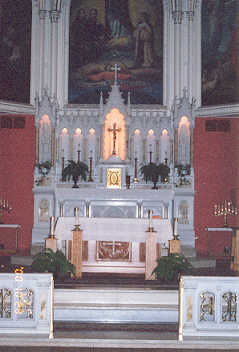
|
Unlike
Christ's earthly sacrifice, which he and he alone offered to the Father, the
Eucharist, by God's gracious design, is also the Church's sacrifice. It is
Christ's sacrifice, but it is also ours, for we are priests and victims along
with Jesus, the chief priest and chief victim. As Christ's offering of himself
is renewed and continued in the Mass, our offering of ourselves is also
included. Furthermore, just as Christ's earthly offering included everything in
his life, so also the offering that we make of ourselves at the Eucharist is
meant to touch all the authentic experiences of our Christian lives. Our
friendships, our love for one another, our service to mankind—all this is part
of our eucharistic offering. Bearing properly with physical pain, frustration,
failure, misunderstanding, boredom, anguish of spirit—this, too, we offer at
the altar. To love and be loved by another human—and to be in wonder at this
mystery of love—is also a cherished part of our eucharistic offering. To enjoy
a meal together, to walk by the seashore, to drink in the morning freshness, to
feel the warmth of the summer sun and the invigorating cold of a winter
day—this also we offer with Jesus. The Eucharist, then, gathers up what would
otherwise be the too-fragmented pieces of our lives and gives them a marvelous
unity, a Christ-like unity. The Eucharist permeates these pieces of our lives
with the love, the beauty, and the strength of Jesus' own offering and then
presents them to the Father under the guidance of the Holy Spirit. We see, then,
the richness and extensiveness of the eucharistic sacrifice's first
element—the interior offering.
|
The
second element of sacrifice—that is, the external, ritualized offering—is
easily recognized at each Eucharist because each Eucharist is a ritual of
celebration. We all know that special days of celebration are important for both
families and civil society. The celebration of a birthday or a wedding
anniversary can do much to lift family spirits. The strictly ordinary is
temporarily dispensed with; family members dress up a bit, have special food and
drink, and otherwise make the day of celebration different from the usual
routine of daily existence. Civil society acts similarly for its days of
celebration; business and industry often close down for the day, parades
frequently mark the occasion, and special banquets or galas help make the day
seem special.
The
Eucharist is the main setting for the celebration of the Christian community.
Some liturgies are very special moments of celebration—Easter and Christmas
are obvious examples. But daily liturgies are celebrations, too, although
obviously on a smaller scale than that of the major liturgical feasts. The daily
liturgy can truly be called a celebration because a special event—the
Christ-event that is centered in Jesus' death-resurrection—is always being
called to memory and sacramentally re-enacted. Furthermore, each liturgy briefly
raises us above—notice, we are not saying that each liturgy falsely separates
us from—the ordinary setting of our lives. Refreshed by the special setting of
the Eucharist and nourished by Christ himself, we are meant to return to the
secular framework of life with a deepened desire to live Christ.
We can easily
conclude from what we have been discussing that the externals of the liturgy
should not become too commonplace. Certainly the rather rigid ritualism of the
pre-Vatican II liturgy is not what we now judge to be desirable. Any
celebration, despite the fact that it purports to be something quite different
from what the participants daily experience, still must allow the participants
to feel at ease with one another and the total situation. The setting of the
Eucharist must likewise allow the participants to feel basically comfortable
with one another and able to experience a sense of familiar connaturality with
the celebration. On the other hand, if the Eucharist is celebration, its
setting, its ritual, cannot become so ordinary that its participants tend to
lose sense of the specialness of the event. Remember, one of the purposes of
celebration is to provide a special type of experience, something quite
different from the ordinary course of our lives. Consequently, the liturgy, as
sign or ritual, has to achieve a rather delicate balance; it must be enacted in
such a manner that we will feel at ease while, at the same time, it still
remains something special.
The balance of ritual also
has to be concerned with another factor. Ritual is also meant to be meaningful,
that is, ritual is meant to point to the invisible realities of the liturgy in a
way that is pertinent and attractive to the participants. The participants, for
their part, have a responsibility toward the sign of the liturgy. The liturgy,
as sign, presupposes the faith of the participants; no matter how perfect the
external liturgy might be, it cannot be really meaningful to one who lacks
faith. Conversely, the deeper the participants' faith is, the more meaningful is
the liturgy of sign. We can also say that the more mature one's faith is, the
better prepared he or she is to bear with possible deficiencies in the liturgy
of sign. Persons of mature faith might well decry these shortcomings and take
all reasonable steps to better the situation, but they will still love the
Eucharist and derive deep meaning from it rather than give up participating in
such a treasured event just because the external liturgy might be deficient.
The
third element of sacrifice, immolation, touches Christ and us because we are
both victims in the eucharistic offering. The immolation of both Jesus and us
is, obviously, an unbloody one. Traditionally, the immolation of Jesus has been
seen in the separate consecration of the bread and wine. Moreover, the very
words of consecration manifest Christ as being in the state of victimhood.
Our
immolation in the Eucharist is a mystical one. Summarily, we become victims with
Christ by conforming our wills in love to the Father's will. Conformity was the
essence of Christ's sacrifice, of his victimhood, of his immolation; a similar
conformity must therefore be found in the victimhood and immolation of Christ's
members. This mystical immolation is a lifelong process; each Eucharist that we
participate in should mark a growth in our victimhood. As true Christians, we
should desire to die more and more to all that is not according to God's will so
that we might rise to greater life with Christ—both here upon earth and in
eternity. Jungmann strikingly portrays the situation: "Every sacrament serves to develop in us the image of Christ according
to a specified pattern which the sacramental sign indicates. Here the pattern is
plainly shown in the double formation of the Eucharist; we are to take part in
His dying, and through His dying are to merit a share in His life. What we here
find anchored fast in the deepest center of the Mass-sacrifice is nothing else
than the ideal of moral conduct to which the teaching of Christ in the Gospel
soars; the challenge to an imitation of Him that is ready to lose its life in
order to win it; the challenge to follow Him even, if need be, in His agony of
suffering and His path of death, which are here in this mystery so manifestly
set before us" (The Mass of the Roman Rite,
p. 146).
We
have said that the fourth element of sacrifice refers to God's acceptance. If
sacrifice is to have its desired effect, it must be pleasing to God. That the
Father always accepts the eucharistic offering is certain, for the principal
priest and victim is Jesus himself who is always supremely acceptable to the
Father. What is more, the Father always accepts the subordinate priesthood and
victimhood of the People of God, for even though the Eucharist may be offered
through the sacrilegious hands of an unworthy priest, there is always a basic
holiness in the Church that is pleasing to God. Because of this holiness, the
Father always accepts the Church's sacrificial offering, for each Mass is the
sacrifice of the whole Church and cannot be fundamentally vitiated by the basic
unworthiness of any particular member or members—even if that member is the
officiating priest.
What
do we say concerning the Father's acceptance of the sacrificial offering of the
individual Christian? Such an offering will be acceptable in proportion to the
Christian's conformity in love to the Father's will. Again, Jungmann has words
for us: "It follows that an interior immolation is required of the
participants, at least to the extent of readiness to obey the law of God in its
seriously obligatory commandments, unless this participation is to be nothing
more than an outward appearance" (Roman Rite, p. 146).
The last element of the
eucharistic sacrifice, the
meal, is, obviously, a very important part. The Eucharist as meal is a rich
reality. It is the sign of Jesus' complete self-giving and, consequently, a sign
of Jesus' fathomless love for us. This sign actually contains what it signifies.
In the Eucharist, Jesus comes to us in his entirety. There is no holding back on
his part; his boundless love for us results in boundless giving.
If the Eucharistic meal is a sign of Jesus'
self-giving, it is also a sign of our self-giving. In receiving divine food, we
pledge ourselves to a deeper God-like existence. We pledge that, in love, we
will strive for a more radical giving of ourselves to both God and others. Each
eucharistic meal that we participate in is a new opportunity for a more perfect
assimilation to Christ and his mysteries, especially the mysteries of death and
resurrection. Each eucharistic meal that we participate in increases our
responsibility to live Christ, that is, to more fully incorporate the Gospel
ideal in all that we do.
The fact that
our participation in the eucharistic meal is a sign of our self-gift not only to
God in Christ, but also to one another leads us to a consideration of the
communal aspect of the meal. The eucharistic meal is a great sign and cause of
our unity in Christ. Rahner maintains that "insofar as everyone
participates in the same meal of Christ, who is the giver and the gift at the
same time, the Eucharist is also the sign, the manifestation and the most real
actualization of the church insofar as the church is and makes manifest the
ultimate unity of all men in the Spirit, a unity which has been founded by God in
grace" (Foundations of Christian Faith, p.
427). We are therefore to receive the one and same Christ, the implications of
which are far-reaching. In receiving the one and same Christ we are actually
pledging ourselves to unity both among ourselves and with all mankind. We are
pledging ourselves to uproot from our hearts those attitudes that work against
the building up of community in the Church and in the world. We are pledging
ourselves to look upon others with a sense of respect, love, and even wonder as
we marvel at how God's love has created and redeemed each one, at how the blood
of Jesus has salvifically touched each one. Our participation in the eucharistic
meal truly pledges us to these ideals. We, for our part, must ask ourselves
whether we are actually assimilating these ideals. We must ask ourselves whether
we are allowing the Eucharist to transform us into more loving and concerned
persons, persons less and less influenced by forces that disrupt and tend to
weaken and destroy communal unity.
|
The
discussion of the communal aspect of the eucharistic meal reminds us that the
entire eucharistic sacrifice is a covenant act. What is covenant? In the
context of salvation history, a covenant is an agreement, a bond, a union, a
life relationship both between God and his people and among the people
themselves. At the Last Supper, Jesus emphasized the covenant aspect of the
Eucharist: "During the meal Jesus took bread, blessed it, broke it, and
gave it to his disciples. 'Take this and eat it,' he said, 'this is my body.'
Then he took a cup, gave thanks, and gave it to them. 'All of you must drink
from it,' he said, 'for this is my blood, the blood of the covenant, to be
poured out in behalf of many for the forgiveness of sins' " (Mt 26:26-28).
When Jesus speaks of his blood as "the blood of the
covenant," we are reminded that blood sealed or ratified the Mosaic
covenant at Mt. Sinai. Moses sprinkled blood upon the altar, which represented
God, and upon the Jewish people. Because blood was a distinctive symbol of life
for the Jews, such an action had a deep significance for them. This action of
Moses symbolized the sealing or ratification of the covenant—a new life
relationship between Yahweh and the Jews.
|
|
 |
The
blood of Jesus has also formed a covenant—the new covenant. In the
shedding of his blood, Jesus has established a new life relationship between his
Father and mankind. Forming a core focal point of redeemed mankind are the
people of the new covenant, namely, the members of the Christian community, the
Church. The Eucharist, in recalling and sacramentally re-enacting the shedding of
Jesus' covenant blood, is the Church's great covenant act. The Eucharist
sustains the life of the covenant, nourishes it, causes it to grow to greater
maturity. Through participation in the eucharistic liturgy we should be growing
in covenant attitudes—in a sense of community, in a deep love of the Church,
in a desire to contribute our share to the building up of this Body of Christ.
We should be learning to curb our selfishness because it deadens a dynamic
concern for the Christian community and makes us a burden to the brethren.
Participation in the Eucharist should also be curbing divisive jealousy, forming
us more and more as persons who want to deeply love one another so that it can
more often be said of us, "See those Christians, how they love one
another." The Eucharist can more radically shape us according to these
covenant attitudes if we allow it. We repent concerning the times we have
resisted; we rejoice concerning the times we have opened ourselves to the
Eucharist's transformative power.
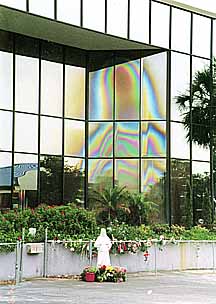
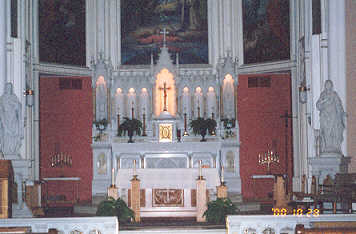


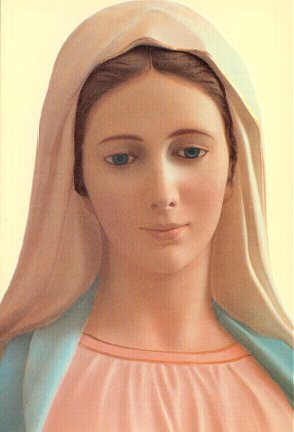
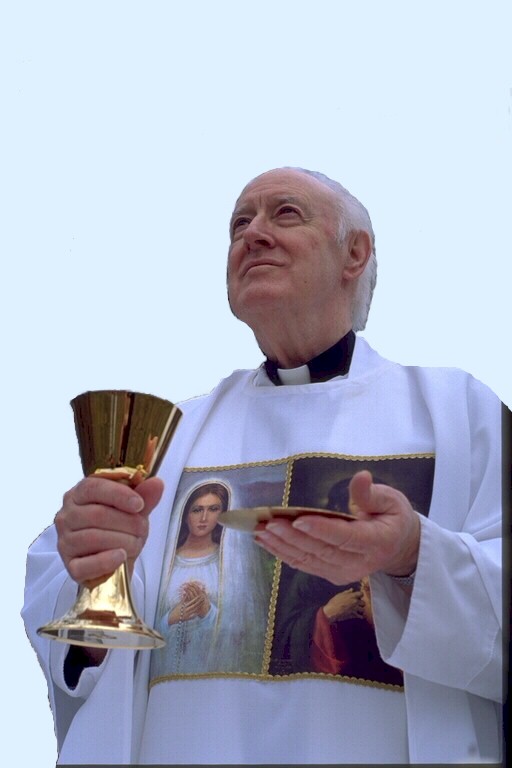

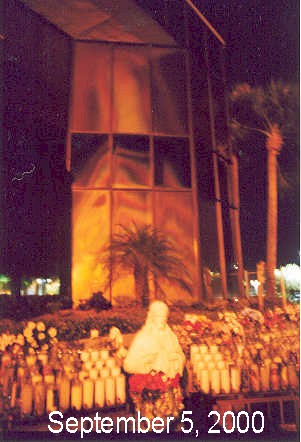


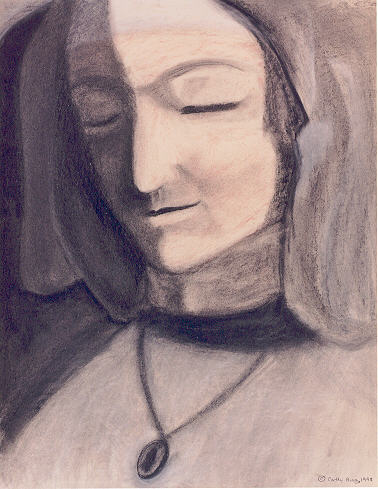 Mary's
Message from the Rosary of August 27, 1996
Mary's
Message from the Rosary of August 27, 1996

